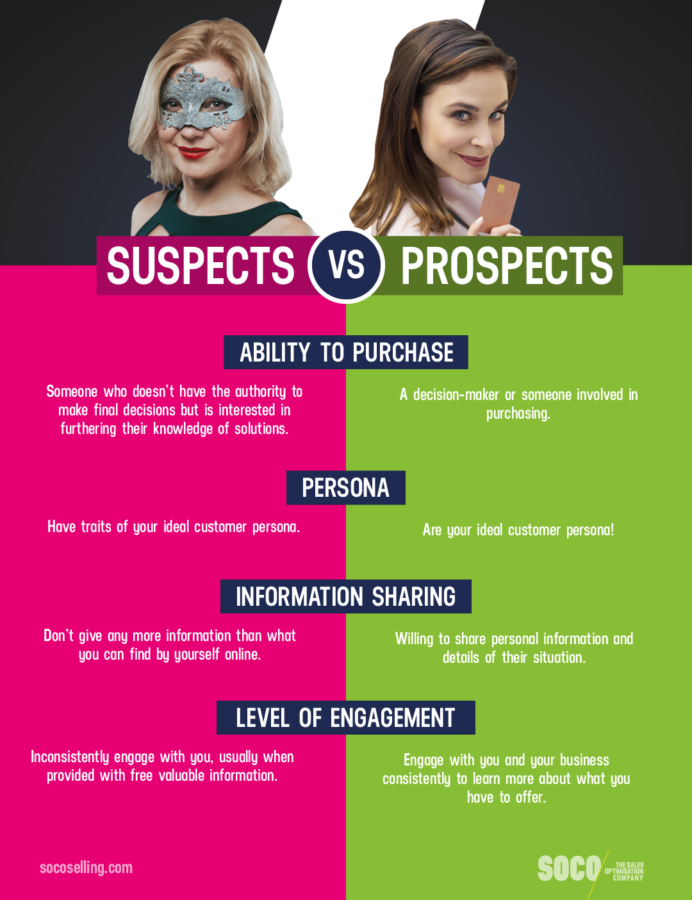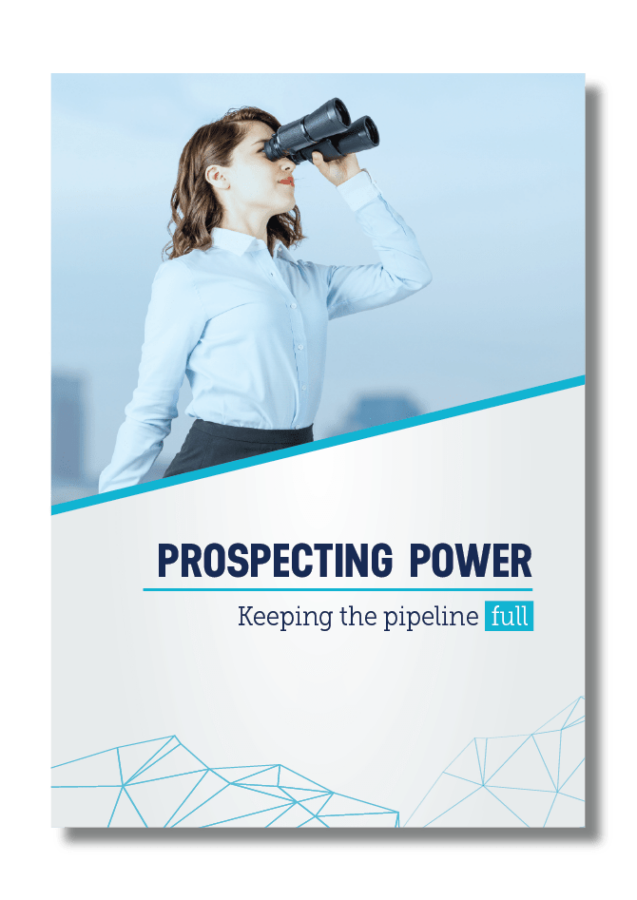
An important part of sales success is keeping your leads organised. Not only is it central to managing your sales pipeline and activities as a whole, but it’s also fundamental to understanding your customers. However, we know that it isn’t always that easy to differentiate between a suspect and a prospect. Especially when at face value, they appear so similar. That’s why in this article, we’ve provided you with our guide to separating suspects and prospects. Read on to learn how to successfully separate and improve the leads in your sales funnel, which will ultimately increase conversions, improve your prospecting efforts and save precious time for other sales activities.
Also read:
- Qualify Prospects: The BANT Sales Methodology
- 8 Buying Motives ALL Salespeople Should Know!
- 9 Different Types of Prospects and How To Sell to Them
Suspects vs Prospects
Before we learn how to separate and improve the leads in your sales funnel, let’s quickly summarise the difference between a suspect and prospect:
What is a suspect?
A sales suspect is someone who lingers in the sales process and funnels without any actual means or intention of buying your products or services. In addition, you may think that they fit your ideal customer persona. Still, you don’t have any other information about them, and they’re unwilling to engage consistently.
What is a prospect?
A sales prospect is someone who is a potential buyer of your product or service. Although they haven’t engaged with you yet or entered your sales process, they are someone who fits your ideal customer persona. Ideally, this means someone with the authority and readiness to purchase; they just haven’t been engaged by your offering yet.
What’s the biggest difference between a suspect and a prospect?
The first difference between a suspect and a prospect is that suspects are motivated by your knowledge rather than what you’re selling. That’s why sales calls and sales presentations don’t work on suspects and result in them remaining stale in your sales funnel. Although that’s not to say they can’t become prospects. Instead, you need to engage them by providing content that is relevant to them. For example, articles containing relevant answers to problems suspects have, industry data, statistics, trends and helpful video guides. In contrast, prospects have already given you their personal information, such as an email address, in exchange for more content.
Also read: The Ultimate Guide To The Sales Prospecting Process (+ Email Templates)
When does a qualified suspect become a prospect?
A suspect becomes a qualified prospect when they have actively supplied their personal information in exchange for more of your content. However, it’s important to remember that they are still not a lead at this stage. Instead, this is a signal they’re ready to be nurtured into one.
Summary of key differences between suspects and prospects
Below is a table summarising the key differences between a suspect and a prospect:
| Suspects | Prospects |
| Someone that often doesn’t have the authority to make final decisions but is interested in furthering their knowledge of solutions. | A decision-maker or someone involved in purchasing. |
| Have traits of your ideal customer persona. | Have your ideal customer persona. |
| Don’t give any more information than what you can find by yourself online. | Willing to share personal information and details of their situation. |
| Inconsistently engage with you, usually when provided with free valuable information. | Engage with you and your business consistently to learn more about what you have to offer. |

How to separate suspects from prospects
We’ve all been there, and it’s one of the most deflating experiences for a sales professional – spending plenty of time and effort into engaging with a prospect to find out they’re not interested in buying. It’s only natural, though, because many other professionals may just be using you as a tool for doing market research. However, there is something you can do to separate suspects from prospects. Check out our recommendations below:
Ask yourself these 3 questions
Ask yourself these questions during sales conversations with potential buyers to ensure you’re constantly actively differentiating suspects and prospects:
1. Have they shared their information?
A likely prospective lead is willing to share personal or sensitive information with you. They have apparent confidence in your relationship and are happy to discuss the possibility of how your product or service would fit into their business.
2. Are you talking to the decision-maker?
Sometimes, a quick Google or social media search can tell you which company member is the decision-maker. This technique allows you to bypass the receptionists and assistants—the gatekeepers. However, before you approach a company or spend any time developing the relationship, the first step is always to qualify the prospect.
3. Have they shared a critical need, challenge or issue?
Like proprietary information, sharing a critical need or challenge flags that a prospective lead is ready to discuss how your solution can seriously help them. These people are definite prospects and will tell you exactly where they’re struggling because they want your help.
Also read: Keep Your Pipeline Moving With THIS 5-Step Prospecting Plan
Understand the SPANCO sales process
What is a SPANCO sales process? It’s the abbreviation of the six stages in a typical sales cycle, usually during every sales process. Read on to understand the process below:

Suspect (Defining your target)
The first stage of the SPANCO sales model involves gathering lists of suspected leads. However, there is no confirmation whether they are interested in buying the product offered. So this requires research and investigating into the account or customer to determine whether they have authority, ability to buy, and carry out a needs assessment of the customer.
Prospect (Lead identification)
Next, prospects are identified from the suspect list. These prospects are the potential customers who express their interest during the previous Suspecting stage and require further communication. At this stage, salespeople need to determine the chances of converting that lead into a long-term relationship with the customer or move on to the next prospective client.
Approach
The approach stage is all about meeting the prospective clients identified during the previous Prospecting stage. The meeting can take place in-person, virtually or over the phone and is focused on identifying the client’s requirements, analyzing them, performing lead qualification and based on that, tries to present a solution from their offerings.
Negotiate
The negotiation stage of the SPANCO sales cycle is one of the most vital -considering that it can either make or break a sales deal. By this stage, salespeople should know their competitor’s product in detail to negotiate areas such as product and services features, pricing, implementation, etc.
Close (Finalising deal)
At this stage, the salesperson needs to agree to the terms and conditions. After signing the agreement with the party, the deal is closed.
Order
Once the Purchase Order (PO) is issued, the salesperson hands it over to the Delivery Team and marks the end of the sales cycle.
Focus on lead classification
Suspect: Someone in your target market/ideal customer persona.
Prospect: Someone who has taken action to solve a problem that you can help with.
Leads: Someone with definite authority and willingness to buy.
Opportunity: The person is considering to buy.
Types of leads classification
- Information Qualified Lead (IQL) or NQL (non-qualified lead):
An Information Qualified Lead is a prospect who is at the start of their solution research process. Often, they’re not aware of the solutions you provide but have exchanged their personal details for your valuable content.
2. MQL (Marketing Qualified Leads):
Rather self-explanatory, but Marketing Qualified Leads are inbound leads from marketing channels. For example, from paid ads, organic search, hosted events, webinars, social media, etc.
3. SQL (Sales Qualified Leads):
A sales qualified lead is a researched prospect prequalified by the marketing department and then by the sales team.
Discover a New Way to Generate Leads
Like blood to a body, a full sales pipeline is necessary for your business to survive. The thing is, prospecting has evolved, and old methods just aren’t effective anymore.
In our Prospecting Power training we teach participants how to ensure your customer acquisition strategy is creative, persistent and, most importantly, generates real results.


